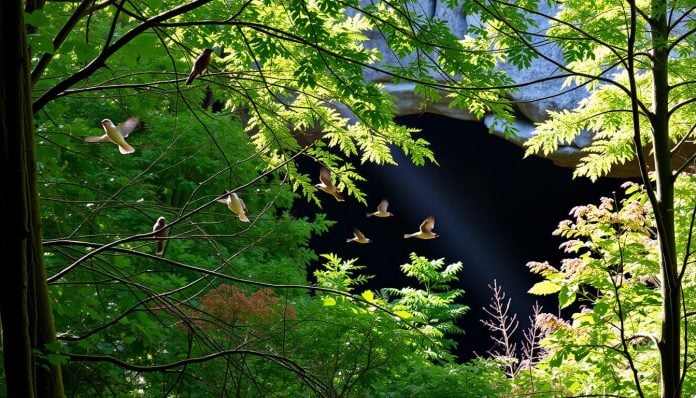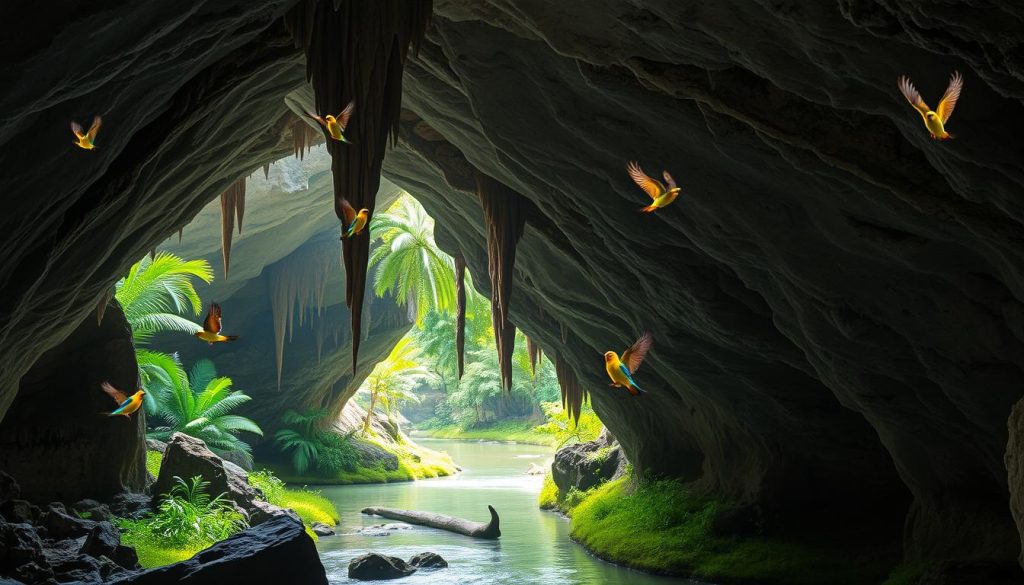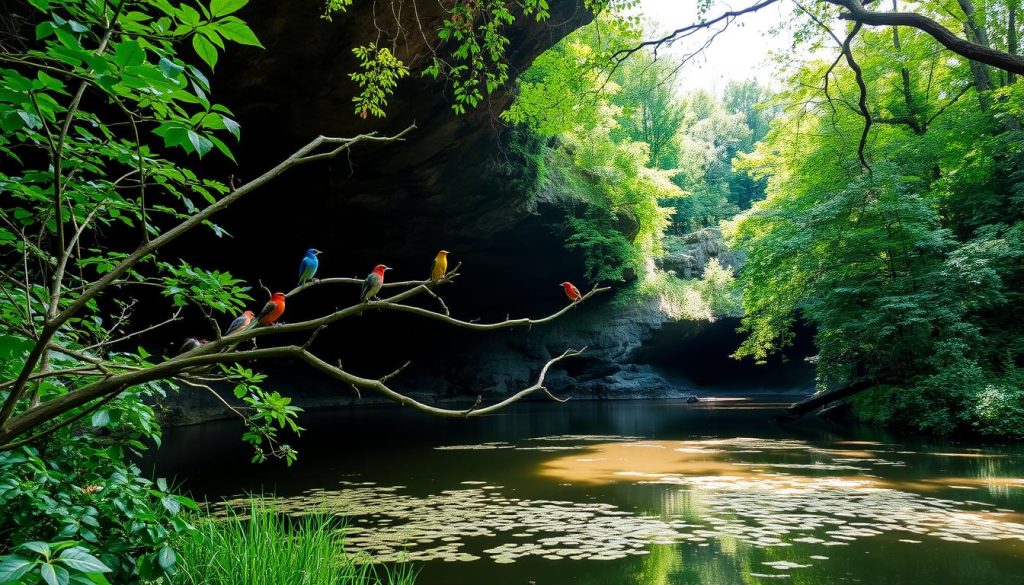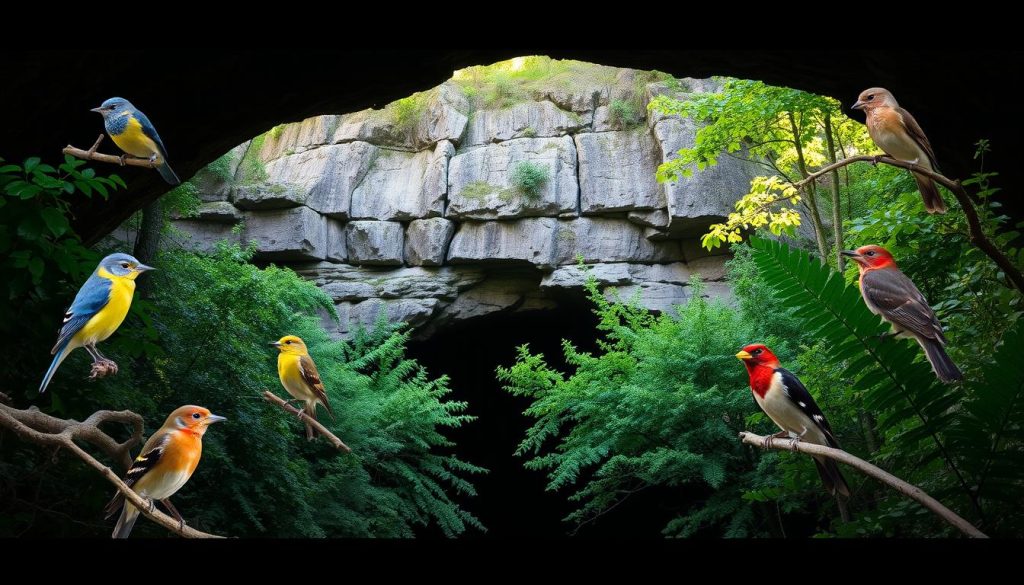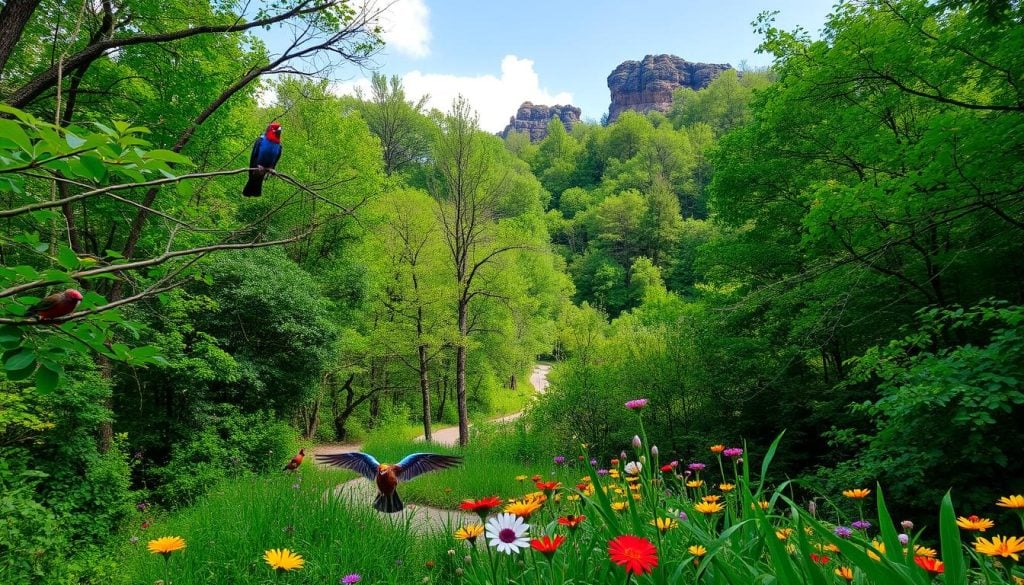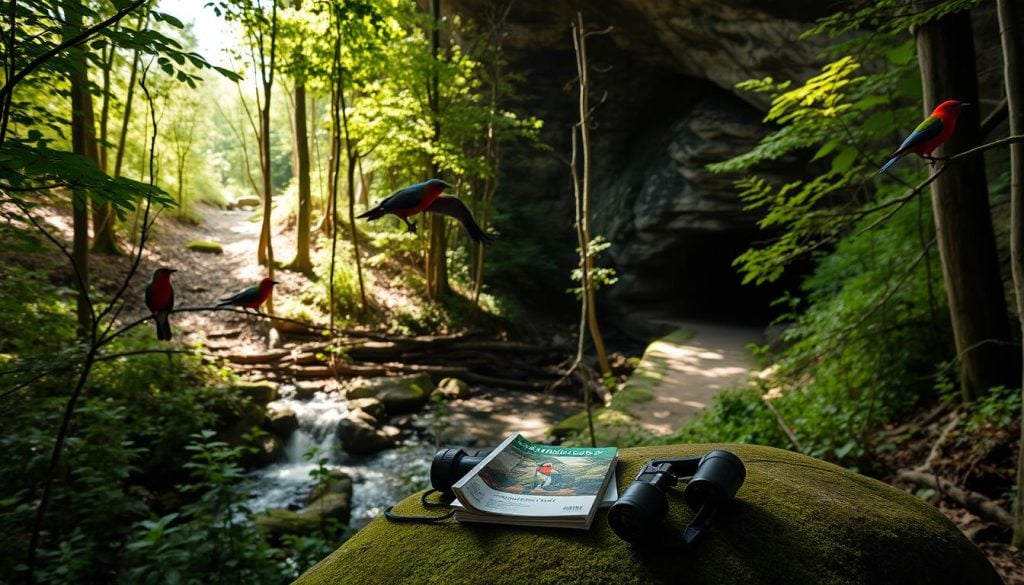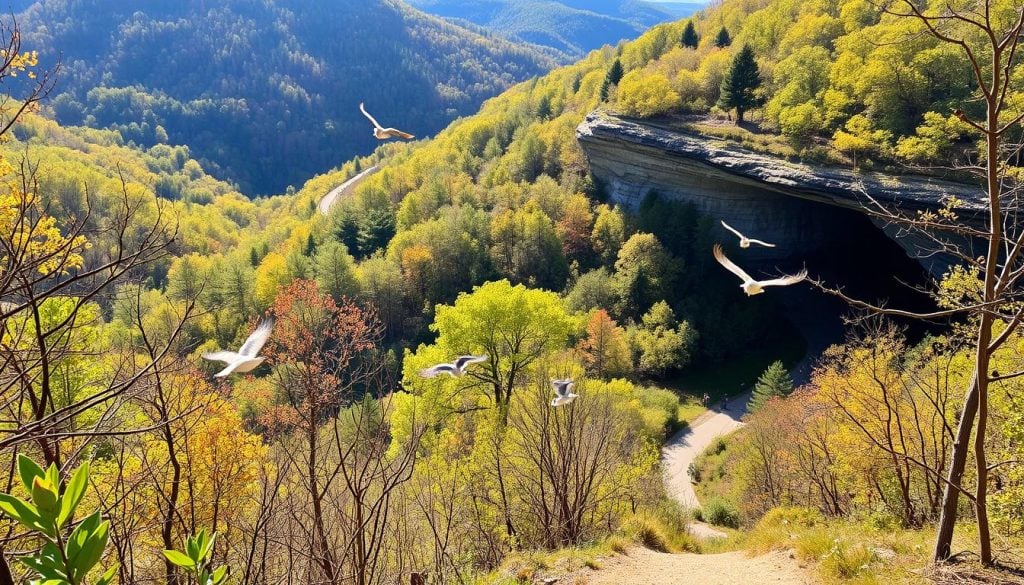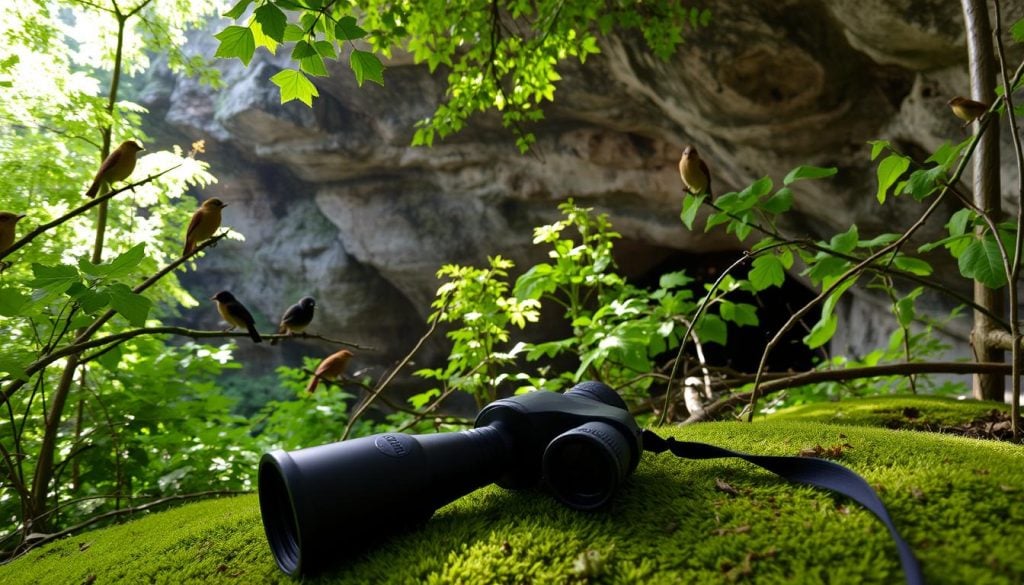Have you ever thought about how seasons change birdwatching at Mammoth Cave? This special place is home to many bird species. It’s great for both seasoned birdwatchers and beginners. In this birdwatching guide, you’ll get vital tips. You’ll find out the best seasons to visit. And you’ll learn about the birds living in Mammoth Cave National Park.
Introduction to Birdwatching at Mammoth Cave
Birdwatching at Mammoth Cave is a special chance to see many birds in a stunning place. The park has different areas like hills, forests, and wetlands. This makes it a top spot for birdwatching, especially in caves where many birds live.
People who love birds find Mammoth Cave birdwatching exciting. You will see birds that live both above ground and below. It’s amazing to see how birds can live in different places. The mix of habitats makes watching birds here interesting all year round.
- The trails offer ample vantage points for spotting birds in their natural habitat.
- A guide on Kentucky birdwatching tours can enhance your experience by providing insights into local species and their behaviors.
- Whether you are an expert or just starting your journey, Mammoth Cave invites you to immerse yourself in a world of avifauna.
Understanding Mammoth Cave National Park Birdwatching
Mammoth Cave National Park birdwatching is perfect for both new and experienced birders. The park’s unique geological formations and lush environment create a fantastic home for many birds. When you visit, take time to learn about the park’s habitat. This includes mixed forests and rivers that are great for birds to feed and nest in.
Over 200 bird species visit the park throughout the year. Some stay all year round while others are just passing through. Birdwatching here lets you see birds acting naturally in their homes. Knowing their calls and when they visit can make your birdwatching even better.
- Birdwatching is best early in the morning and late in the afternoon.
- Looking up trails known for bird sightings can help you see more.
- Patience and careful watching are important. Birds might not appear right away.
| Season | Species to Observe | Best Time for Observation |
|---|---|---|
| Spring | Warblers, Sparrows | Morning |
| Summer | Hawks, Orioles | Late Afternoon |
| Fall | Geese, Woodpeckers | All Day |
| Winter | Cardinals, Chickadees | Mid-Morning |
Understanding birdwatching at Mammoth Cave National Park shows you the importance of species and their environments. It highlights the beauty and complexity of nature.
Key Bird Species in Mammoth Cave
Mammoth Cave is a special place for different Mammoth Cave bird species. Bird lovers find it thrilling. The park is home to birds that showcase the area’s unique ecosystems. The Cerulean Warbler, Kentucky Warbler, and Worm-eating Warbler stand out. They live in particular areas and knowing about them makes birdwatching better.
You might also see Pileated Woodpeckers and Eastern Bluebirds at Mammoth Cave. These birds are part of the park’s colorful bird world. Learning about common Southeastern birds Mammoth Cave helps us understand their lives. This includes where they nest, how they move, and much more. Below, there’s a table with some key birds you could spot in the park:
| Bird Species | Habitat | Behavior |
|---|---|---|
| Cerulean Warbler | Deciduous forests | Sings from tree tops; often seen in the upper canopy |
| Kentucky Warbler | Thickets and low growth | Active forager; often found near the ground |
| Worm-eating Warbler | Wooded areas | Forages on the ground, often hidden in leaf litter |
| Pileated Woodpecker | Mature forests | Drills deep holes in trees to find insects |
| Eastern Bluebird | Open fields and wooded borders | Often seen perched; feeds on insects and berries |
Birdwatching Mammoth Cave: Tips for Success
Get the most out of your birdwatching at Mammoth Cave by knowing the right gear and best practices. Being well-prepared boosts your enjoyment and the chance of great sightings.
Essential Gear for Birdwatching
The correct equipment can greatly enhance your birdwatching experience. Here’s a list of gear you should consider:
- Binoculars: A top-notch pair is essential for seeing birds that are far away.
- Field Guides: They help identify the different species you’ll come across.
- Durable Footwear: Mammoth Cave’s varied terrain calls for strong shoes to keep you comfy.
- Weather-Appropriate Clothing: Dress in layers so you can easily adjust to weather changes.
- Apps for Bird Identification: Birding apps are great for improving your skill in recognizing birds.
Best Practices for Birdwatching
Adopting good habits can make birdwatching respectful and enjoyable. Remember these tips:
- Be Patient: Taking time to quietly observe can increase your chances of seeing rare birds.
- Stay Quiet: Keeping noise to a minimum helps avoid scaring birds and changing their behavior.
- Respect Wildlife: Keep your distance and don’t disturb birds in their natural setting.
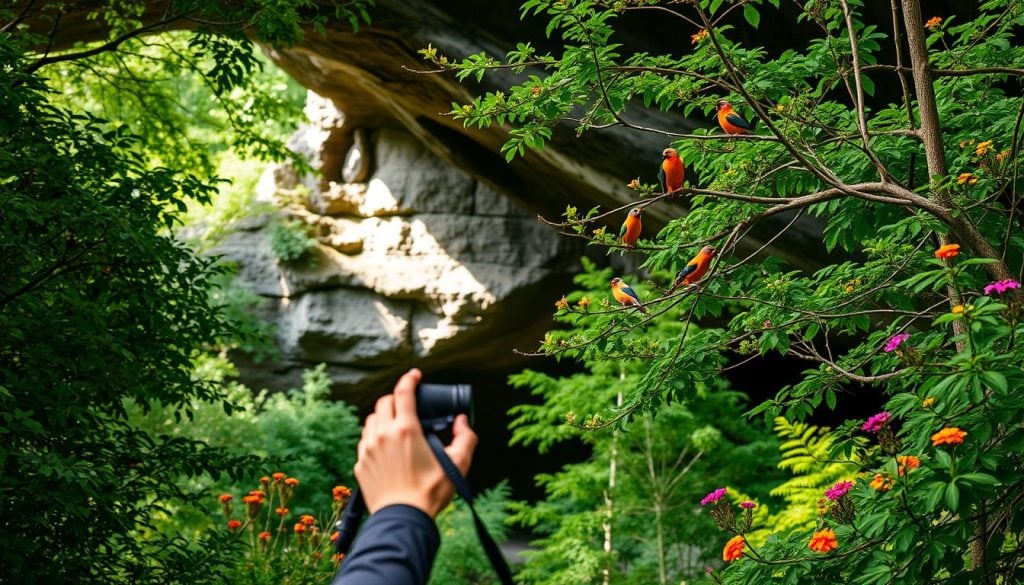
Exploring Birdwatching Trails in Mammoth Cave
Mammoth Cave has many birdwatching trails for all kinds of bird fans. You can find trails that are easy or hard, depending on what you like. The Heritage Trail and Maple Spring Trail are favorites because they’re different in how long and tough they are.
The Heritage Trail is about 2 miles long and easy to walk. It’s perfect for families and those new to birdwatching. You might see the Eastern Bluebird and American Robin here. On the other hand, the Maple Spring Trail is 1.5 miles long. It’s a bit tougher, especially for new hikers, but you could see rare birds like the Wood Thrush or Scarlet Tanager.
Some tips for these trails are to always carry a good map and pay attention to where you are. Knowing about the season can help you guess what birds you’ll see. For a better chance to see birds, go in the early morning. That’s when many birds are most active.
No matter if you want an easy walk or a more challenging hike, Mammoth Cave’s birdwatching trails are worth exploring. They offer great chances to connect with nature.
The Best Seasons for Birdwatching at Mammoth Cave
Birdwatching at Mammoth Cave is best in spring and summer. These seasons show the area’s vibrant bird life. Each season brings different birds to see.
Spring Migration and Bird Species
Spring is busy in the bird world. Birds come back to their breeding spots. You’ll see warblers, thrushes, and flycatchers at Mammoth Cave then. It’s a colorful and musical time for nature fans.
Summer Birdwatching Opportunities
Summer makes birdwatching at Mammoth Cave magical. Birds are in their bright breeding colors. You might see the indigo bunting and woodpeckers. Birds are more active, making summer a great time to watch them. The green leaves also hide nests, adding to the fun of birdwatching. Use the long days to walk the trails and enjoy the park’s wildlife.
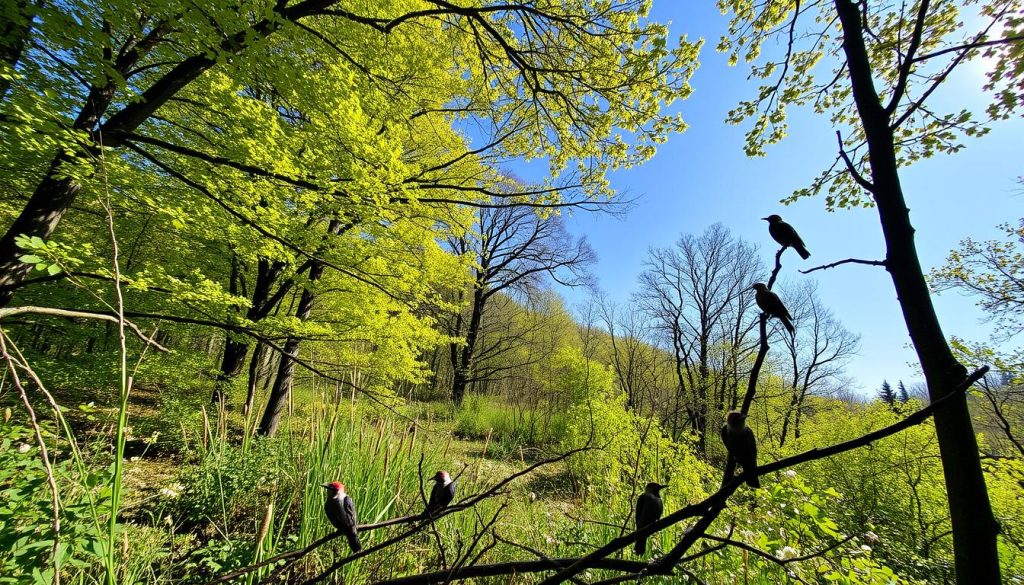
Mammoth Cave Birding Tips for Beginners
Starting your birdwatching journey is exciting. Learning to identify common birds is key. These tips will make birding more enjoyable.
How to Identify Common Birds
Look for key features to tell birds apart. Focus on their size, colors, and how they act. Remember these points:
- Color and Markings: Look for main colors and special patterns like stripes.
- Size: Compare the bird’s size with common ones like sparrows.
- Calls and Songs: Recognize the usual sounds of local birds.
- Flight Patterns: Notice how different birds move in the sky, some might flutter, others glide.
Resources for Birdwatching Education
There are many ways to learn more about birdwatching. You can join clubs or online groups for help. Check out these resources:
- Local Birding Clubs: Meet other birdwatchers to get tips and stories.
- Online Forums: Ask questions and join conversations about birdwatching online.
- Field Guides: A good book can teach you about Mammoth Cave’s birds.
- Mobile Apps: Apps help you identify and track birds easily.
Birdwatching Hotspots in Mammoth Cave National Park
Mammoth Cave National Park is perfect for birdwatching. You can find unique spots like riverbanks and scenic overlooks. These places are great for seeing different kinds of birds.
Near rivers, many shorebirds gather. These spots are important for their food and nesting. You might see the Great Blue Heron or ducks any time of the year. The early morning is the best time to catch them.
Clearings in the forest attract songbirds. You’ll find them near trailheads, singing beautifully. Species like the Eastern Towhee and White-throated Sparrow are common. Early spring is a good time to visit, especially when birds migrate back.
Overlooks give you a great view for birdwatching. Here, you can spot hawks and vultures flying above. The high spots make it easier to see these amazing birds in the sky.
To make the most out of birdwatching, remember this:
- Best time to visit: Early mornings and late afternoons.
- Seasonal considerations: Spring migratory season brings many species.
- Be quiet: Stay silent to not scare the birds.
With some planning and patience, you can have great birding experiences at Mammoth Cave. You’ll enjoy memorable sightings.
Participating in Birdwatching Tours in Kentucky
Joining Kentucky birdwatching tours is a special way to see the Mammoth Cave area’s wildlife. These tours take you through beautiful scenery and help improve your birdwatching abilities. Expert guides share knowledge about local birds, where they live, and the area’s nature.
On birdwatching Mammoth Cave tours, you’ll get a hand-picked experience. You could spend hours or a whole day watching birds like woodpeckers and warblers. Guides adapt the tour for beginners to experts, making sure everyone learns.
To get the most out of birdwatching, remember these tips:
- Booking Options: Look for tours on local groups’ websites or call them to book.
- What to Bring: Don’t forget your binoculars, a bird guidebook, and clothes for the weather.
- Educational Insights: You’ll learn how to identify birds and how changes in the environment affect them.
Birdwatching tours bring you closer to nature. They are more than a hobby; they’re an educational journey. By going on a Kentucky birdwatching tour, you deepen your skills and connect with the outdoors in a profound way.
Conclusion
Birdwatching at Mammoth Cave National Park is a unique way to connect with nature. The park hosts a variety of birds throughout the year. Knowing the best times to visit enhances your birdwatching experience.
Remember to follow the tips and respect wildlife as you prepare. Bring necessary gear and care for bird habitats. These actions help preserve the birds we admire.
Exploring Mammoth Cave’s birds can deepen your love for nature. With this guide, you’re ready to fully enjoy birdwatching. You’ll also encourage others to appreciate these birds. Happy birdwatching!

































